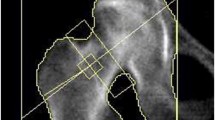Abstract
Objectives
Pitfalls in dual-energy x-ray absorptiometry (DXA) are common. Our aim was to assess rate and type of errors in DXA examinations/reports, evaluating a consecutive series of DXA images of patients examined elsewhere and later presenting to our institution for a follow-up DXA.
Methods
After ethics committee approval, a radiologist retrospectively reviewed all DXA images provided by patients presenting at our institution for a new DXA. Errors were categorized as patient positioning (PP), data analysis (DA), artefacts and/or demographics.
Results
Of 2,476 patients, 1,198 had no previous DXA, while 793 had a previous DXA performed in our institution. The remaining 485 (20 %) patients entered the study (38 men and 447 women; mean age ± standard deviation, 68 ± 9 years). Previous DXA examinations were performed at a total of 37 centres. Of 485 reports, 451 (93 %) had at least one error out of a total of 558 errors distributed as follows: 441 (79 %) were DA, 66 (12 %) PP, 39 (7 %) artefacts and 12 (2 %) demographics.
Conclusions
About 20 % of patients did not undergo DXA at the same institution as previously. More than 90 % of DXA presented at least one error, mainly of DA. International Society for Clinical Densitometry guidelines are very poorly adopted.
Key Points
• More than 90 % of DXA examinations/reports presented one or more errors.
• About 80 % of errors are related to image data analysis.
• Errors in DXA examinations may have potential implications for patients’ management.





Similar content being viewed by others
References
Consensus Development Conference (1993) Diagnosis, prophylaxis, and treatment of osteoporosis. Am J Med 94:646–650
Kanis JA, McCloskey EV, Johansson H, Cooper C, Rizzoli R, Reginster JY et al (2013) European guidance for the diagnosis and management of osteoporosis in postmenopausal women. Osteoporos Int 24(1):23–57
Kanis JA, Oden A, Johnell O et al (2007) The use of clinical risk factors enhances the performance of BMD in the prediction of hip and osteoporotic fractures in men and women. Osteoporos Int 18(8):1033–1046
WHO (2007) Assessment of osteoporosis at the primary health care level. Report of a WHO Scientific Group. http://www.who.int/chp/topics/rheumatic/en/index.html. Accessed 21 Jun 2014
Blake GM, Fogelman (2007) Role of dual-energy x-ray absorptiometry in the diagnosis and treatment of osteoporosis. J Clin Densitom 10(1):102–110
Bandirali M, Sconfienza LM, Aliprandi A et al (2014) In vivo differences among scan modes in bone mineral density measurement at dual-energy x-ray absorptiometry. Radiol Med 119(4):257–260
El Maghraoui A, Achemlal L, Bezza A (2006) Monitoring of dual-energy x-ray absorptiometry measurement in clinical practice. J Clin Densitom 9(3):281–286
Delnevo A, Bandirali M, Di Leo G et al (2013) Differences among array, fast array, and high-definition scan modes in bone mineral density measurement at dual-energy x-ray absorptiometry on a phantom. Clin Radiol 68(6):616–619
International Society for Clinical Densitometry (2013) Official positions of the International Society for Clinical Densitometry. http://www.iscd.org/official-positions/2013-iscd-official-positions-adult/. Accessed 21 Jun 2014
Watts NB (2004) Fundamentals and pitfalls of bone densitometry using dual-energy x-ray absorptiometry (DXA). Osteoporos Int 15(11):847–854
Garg MK, Kharb S (2013) Dual energy x-ray absorptiometry: pitfalls in measurement and interpretation of bone mineral density. Indian J Endocrinol Metab 17(2):203–210
Hologic (2000) QDR series user’s guide. Hologic, Bedford
Bachrach LK (2000) Dual energy x-ray absorptiometry (DEXA) measurements of bone density and body composition: promise and pitfalls. J Pediatr Endocrinol Metab 13(Suppl):983–988
Gafni RI, Baron J (2004) Overdiagnosis of osteoporosis in children due to misinterpretation of dual-energy x-ray absorptiometry (DEXA). J Pediatr 144(2):253–257
Leonard MB, Propert KJ, Zemel BS, Stallings VA, Feldman HI (1999) Discrepancies in pediatric bone mineral density reference data: potential for misdiagnosis of osteopenia. J Pediatr 135:182–188
Prentice A, Parsons TJ, Cole TJ (1994) Uncritical use of bone mineral density in absorptiometry may lead to size-related artifacts in the identification of bone mineral determinants. Am J Clin Nutr 60:837–842
Preidler KW, White LS, Tashkin J et al (1997) Dual-energy x-ray absorptiometric densitometry in osteoarthritis of the hip. Acta Radiol 38:539–542
Rand T, Seidl G, Kainberger F et al (1997) Impact of spinal degenerative changes on the evaluation of bone mineral density with dual energy x-ray absorptiometry (DXA). Calcif Tissue Int 60(5):430–433
Muraki S, Yamamoto S, Ishibashi H et al (2004) Impact of degenerative spinal diseases on bone mineral density of the lumbar spine in elderly women. Osteoporos Int 15(9):724–728
Lekamwasam S, Lenora RS (2003) Effect of leg rotation on hip bone mineral density measurements. J Clin Densitom Winter 6(4):331–336
US Preventive Services Task Force (2011) Screening for osteoporosis: US Preventive Services Task Force recommendation statement. Ann Intern Med 154(5):356–364
Acknowledgements
The scientific guarantor of this publication is Dr. Carmelo Messina. The authors of this manuscript declare no relationships with any companies whose products or services may be related to the subject matter of the article. The authors state that this work has not received any funding. No complex statistical methods were necessary for this paper. Institutional review board approval was obtained. Written informed consent was waived by the institutional review board. Methodology: retrospective, cross sectional study, performed at one institution.
Author information
Authors and Affiliations
Corresponding author
Rights and permissions
About this article
Cite this article
Messina, C., Bandirali, M., Sconfienza, L.M. et al. Prevalence and type of errors in dual-energy x-ray absorptiometry. Eur Radiol 25, 1504–1511 (2015). https://doi.org/10.1007/s00330-014-3509-y
Received:
Revised:
Accepted:
Published:
Issue Date:
DOI: https://doi.org/10.1007/s00330-014-3509-y




